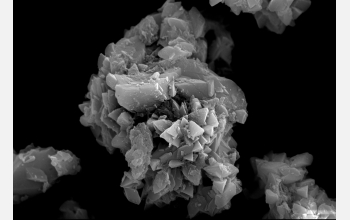|

Discovery
Nano-engineered Powders Tackle Toxic Chemicals

Thirsty grains act fast to clean up messes
April 28, 2005
Composed of magnesium, titanium and oxygen, the toxic-chemical cleaner known as FAST-ACT is unremarkable at first glance. Yet, this new family of powders packs a punch--crammed onto each tiny grain is an enormous surface area and a seemingly limitless thirst for hazardous substances.
When sprayed from a canister or spread over a spill, the material grabs onto and rapidly breaks apart such deadly materials as VX nerve gas and sulfuric acid.
The video above shows just what FAST-ACT can do.
With support from the National Science Foundation (NSF), Kansas State University chemist Kenneth Klabunde was the first to devise the nano-engineering techniques that led to the development of FAST-ACT. He then founded NanoScale Materials, Inc. to produce this new family of substances.
More recently, with support from NSF's Small Business Innovation Research (SBIR) program, the company created the manufacturing processes for commercial-scale production. The SBIR and Small Business Technology Transfer (STTR) programs target small businesses and their partners at universities, enabling the companies to pursue high-risk science and engineering research that could one day prove both useful and economically valuable. In fiscal year 2004, NSF provided just over $100 million to support small business programs.
A listing of Klabunde's NSF awards follows this text.
Kenneth Klabunde recently won a Popular Mechanics Breakthrough Award for his work on FAST-ACT.
NSF Contact: Josh Chamot, (703) 292-7730, jchamot@nsf.gov
NanoScale Materials, Inc. Contact: Kyle Knappenberger, (785) 537-0179 x 134, kbk@NanoActive.com
Investigators
Kenneth Klabunde
Related Institutions/Organizations
Kansas State University
Nanoscale Materials, Inc.
Locations
Bulgaria
Manhattan
, Kansas
Related Programs
International Information and Analysis
Small Business Innovation Research & Small Business Technology Transfer
Related Awards
#0234686 Size and Shape of Small Crystals Affect Surface Chemistry and Consolidation. Rational Synthetic Methods
#0124080 U.S. - Bulgarian Cooperative Research: Synthesis of Large Quantities of Conductive Nanoparticles. Possible Applications in Batteries
#0091369 SBIR Phase II: Reactive Nanoparticles as Destructive Adsorbents
#9986091 Shape and Size of Small Crystals Can Affect Surface Chemistry and Consolidation
#9961227 SBIR Phase I: Reactive Nanoparticles as Destructive Adsorbents
#9727193 U.S.-Bulgarian Cooperative Research: Nanoscale Metal/Boride Particles Containing Rare Earth Elements
#9404694 Chemistry of Free Atoms and Reactive Clusters/Particles
#9115964 Metal Colloids and Thin Films
#9106649 Chemistry of Free Atoms and Reactive Clusters/Particles
#9102281 Mass Spectrometry for Augmenting Organic and Inorganic Synthesis
#8805187 Organic Chemistry of Free Atoms, Particles, and Their Mimics
#8619852 Metal Colloids and Thin Films
#8619143 Purchase of a Fourier Transform Infrared Spectrometer
#8505906 Organic Chemistry of Free Atoms, Particles and Their Mimics
#8310646 Purchase of a Tunable Laser Facility (Chemistry)
#8207107 Purchase of a Multinuclear Magnetic Resonance Spectrometer (Chemistry)
#8201943 Organic Chemistry of Metal Vapors and Metal Oxide Vapors (Chemistry)
#8004120 Purchase of a Mass Spectrometer
#7919587 Organic Chemistry of Metal Vapors and Metal Salt Vapors
#7708707 Travel to Attend: 8th International Conference on Organometallic Chemistry, Kyoto, Japan, 08/25-09/16/77
#7402713 Use of Reactive, Free Metal Atoms & Small Molecules For Synthesis of Unusual Organometal, Fluoroorganometal, & Non- Metal Mat. Novel Struct &Possible Applica
Total Grants
$4,014,912
Related Websites
NanoScale Materials, Inc.: http://www.nanoactive.com/
|
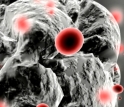
Artist's interpretation of FAST-ACT absorbing and destroying toxins
Credit and Larger Version
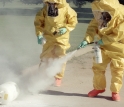
Emergency response personnel from the Topeka, Kansas, fire department test FAST-ACT.
Credit and Larger Version
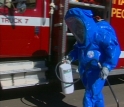
Emergency responder preparing to demonstrate effective use of FAST-ACT.
Credit and Larger Version
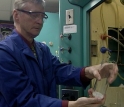
FAST-ACT developer Ken Klabunde holds canister of the powder he developed.
Credit and Larger Version
|


